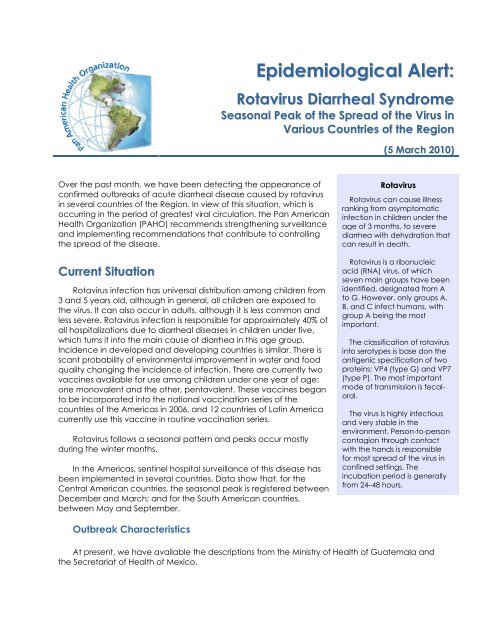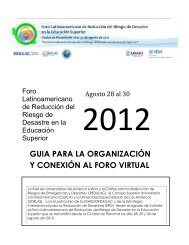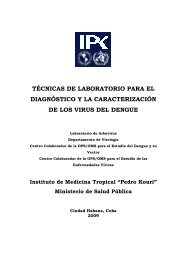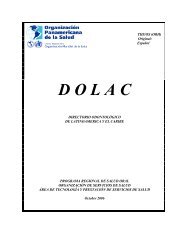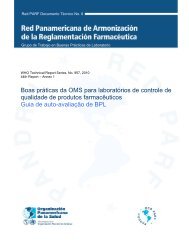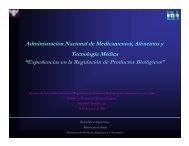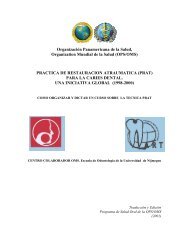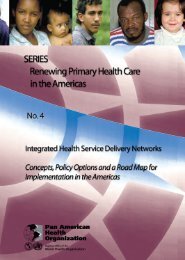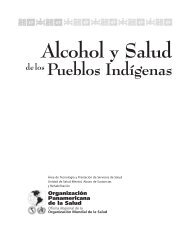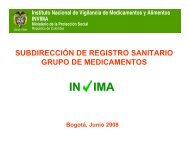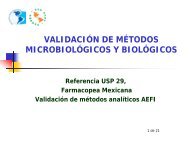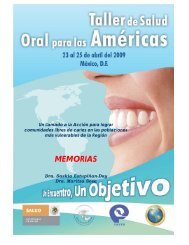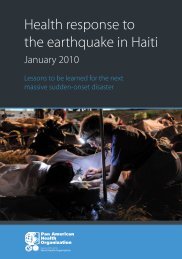Epidemiological Alert: Rotavirus Diarrheal Syndrome
Epidemiological Alert: Rotavirus Diarrheal Syndrome
Epidemiological Alert: Rotavirus Diarrheal Syndrome
You also want an ePaper? Increase the reach of your titles
YUMPU automatically turns print PDFs into web optimized ePapers that Google loves.
<strong>Epidemiological</strong> <strong>Alert</strong>:<strong>Rotavirus</strong> <strong>Diarrheal</strong> <strong>Syndrome</strong>Seasonal Peak of the Spread of the Virus inVarious Countries of the Region(5 March 2010)Over the past month, we have been detecting the appearance ofconfirmed outbreaks of acute diarrheal disease caused by rotavirusin several countries of the Region. In view of this situation, which isoccurring in the period of greatest viral circulation, the Pan AmericanHealth Organization (PAHO) recommends strengthening surveillanceand implementing recommendations that contribute to controllingthe spread of the disease.Current Situation<strong>Rotavirus</strong> infection has universal distribution among children from3 and 5 years old, although in general, all children are exposed tothe virus. It can also occur in adults, although it is less common andless severe. <strong>Rotavirus</strong> infection is responsible for approximately 40% ofall hospitalizations due to diarrheal diseases in children under five,which turns it into the main cause of diarrhea in this age group.Incidence in developed and developing countries is similar. There isscant probability of environmental improvement in water and foodquality changing the incidence of infection. There are currently twovaccines available for use among children under one year of age:one monovalent and the other, pentavalent. These vaccines beganto be incorporated into the national vaccination series of thecountries of the Americas in 2006, and 12 countries of Latin Americacurrently use this vaccine in routine vaccination series.<strong>Rotavirus</strong> follows a seasonal pattern and peaks occur mostlyduring the winter months.In the Americas, sentinel hospital surveillance of this disease hasbeen implemented in several countries. Data show that, for theCentral American countries, the seasonal peak is registered betweenDecember and March; and for the South American countries,between May and September.<strong>Rotavirus</strong> R<strong>Rotavirus</strong> can cause illnessranking from asymptomaticinfection in children under theage of 3 months, to severediarrhea with dehydration thatcan result in death.<strong>Rotavirus</strong> is a ribonucleicacid (RNA) virus, of whichseven main groups have beenidentified, designated from Ato G. However, only groups A,B, and C infect humans, withgroup A being the mostimportant.The classification of rotavirusinto serotypes is base don theantigenic specification of twoproteins: VP4 (type G) and VP7(type P). The most importantmode of transmission is fecaloral.The virus is highly infectiousand very stable in theenvironment. Person-to-personcontagion through contactwith the hands is responsiblefor most spread of the virus inconfined settings. Theincubation period is generallyfrom 24–48 hours.Outbreak CharacteristicsAt present, we have available the descriptions from the Ministry of Health of Guatemala andthe Secretariat of Health of Mexico.
GuatemalaSince <strong>Epidemiological</strong> Week (EW) 1 through 8, Guatemala has reported a total of 4,336cases, of which 964 have been laboratory confirmed, with 3 deaths (in Izabal, Jutiapa, andPetén Norte). The most affected age group is children from 1 to 4 years, followed by infants lessthan a year old and then by children from 5 to 9. The departments with the greatest number ofcases are Santa Rosa, Escuintla, Retalhuleu, Izabal, and Huehuetenango. The Guatemalanauthorities have reported that prior to the period of high circulation, they had been carrying outrotavirus prevention and control measures; and that upon detecting the outbreak, they alertedhealth services for diagnosis and timely case management, including the distribution of oralrehydration salts. In addition, at the community level, information and communication activitieswere initiated aimed at reinforcing hygiene measures and timely case consultation.MexicoAccording to the National <strong>Epidemiological</strong> Surveillance System (Sistema Nacional deVigilancia Epidemiológica / SINAVE), the number of suspected cases of acute enteritis fromrotavirus reported up to the month of February 2010 exceeds the number of cases reportedduring the same period from previous years. Although the cases are distributed throughout 23states, the greatest percentage has been reported in Chiapas (30%), Baja California (13%),Oaxaca (12%), Tamaulipas (8%), San Luis de Potosí (5%), and Sinaloa (5%).In the state of Chiapas, 1,319 suspected cases of rotavirus were reported between EW 1 and9. Of the 897 samples analyzed, the presence of rotavirus was confirmed in 393 of them. Eightsanitary districts in Chiapas have reported suspected cases, and rotavirus has been confirmed infive of them. The first case was reported in Tapachula on 2 January 2010; and since 21 January,a rising trend has been reported, reaching the maximum number of cases on 9 February. Since15 February, the trend has fallen both in the number of suspected cases and in those confirmed.However, the outbreak continues to be active; and suspected cases are still being reported andare in the process of being diagnosed.Although rotavirus cases have been found of different genotypes, the <strong>Epidemiological</strong>Diagnostics and Reference Institute (Instituto de Diagnóstico y Referencia Epidemiológicos /InDRE) has identified a high predominance of the genotype G9 e-type short, an emerginggenotype not included in the composition of the vaccine. A complete vaccination seriesbackground was corroborated in 51 (13%) of the confirmed cases.Based on the temporal and geographical distribution, it is considered that this outbreakcould have started from a common source, although its origin has not been specified. In 224cases, the consumption of non-chlorinated water has been identified as a risk behavior.The Mexican health authorities issued an alert for this event on 22 February, stronglyrecommending reinforced vaccination activities.1. Recommendationsa) <strong>Epidemiological</strong> Surveillance Measures and Outbreak Investigation• Implement and/or reinforce sentinel hospital surveillance of rotavirus diarrhealsyndrome in children under 5.• Immediately notify health authorities of any outbreak detected.2
• Investigate suspected rotavirus cases and collect fecal samples to confirm infectionthrough Enzyme-Linked ImmunoSorbent Assay (ELISA) testing and subsequentidentification of the viral genotype.• Once the outbreak has been identified and confirmed in a specific locality, it is nolonger necessary to collect a sample of each suspected case, and remaining cases willbe confirmed by epidemiological link. However, at least 10 to 20 fecal samples fromcases in each area should be kept for confirmation of viral spread and circulatinggenotype.• Send 10% of all samples positive for rotavirus to reference laboratories for ELISA testingto determine genotype.• Analyze the information by time, place, and person.• Disseminate the information on viral circulation so that it reaches both health workersand the general public, alerting them as to the severity of diarrhea from rotavirus inchildren.b) Preventive Measures• Organize services to capture, diagnose, and manage cases.• The countries that have introduced the oral rotavirus vaccine should continue theirroutine vaccination among children less than a year old.• Advise parents on the need to take their child to a health facility for care andhydration, given the risk of severe dehydration and death.• Because the virus is often spreads through contaminated hands, encourage constanthand-washing, especially after handling a sick child.• It is important that families and healthcare and daycare personnel quickly gather upany waste from sick children and flush it down the toilet.• Drinking water should be taken from the cleanest available source and should beboiled.• It is highly recommended that mothers exclusively breastfeed their babies in order toreduce their being exposed to the virus.• For healthcare personnel, aseptic and antiseptic guidelines should be closely followed:o Always use gloves and gowns with patients and follow personal protectivemeasures.ooc) Patient Care MeasuresWash your hands after caring for a person with diarrhea.Disinfect furniture and medical equipment to avoid contaminating otherpatients and/or staff.• Treatment consists of restoring lost liquids. When vomiting and diarrhea are severe, oralrehydration therapy becomes necessary; and in more severe cases, intravenousrehydration often becomes necessary. The use of antibiotics is inappropriate.• Establish the level of dehydration based on the signs present to choose the mostappropriate treatment. The child should be evaluated and treated according to therules and plans for prevention and management of diarrhea that are available in theIMCI (Integrated Management of Childhood Illness) manuals.• It is not necessary to isolate any person presenting rotavirus diarrheal syndrome, nor tobar children from their healthcare facilities. However, as long as excretion and spreadof the virus persists, generally up to the eighth day of infection, one should avoidchildren having direct contact with persons who are ill.3


